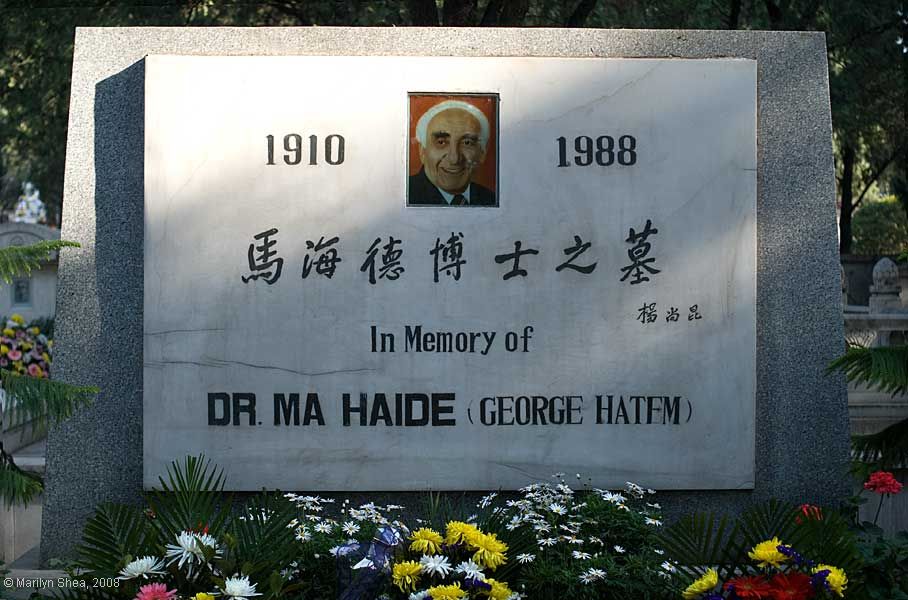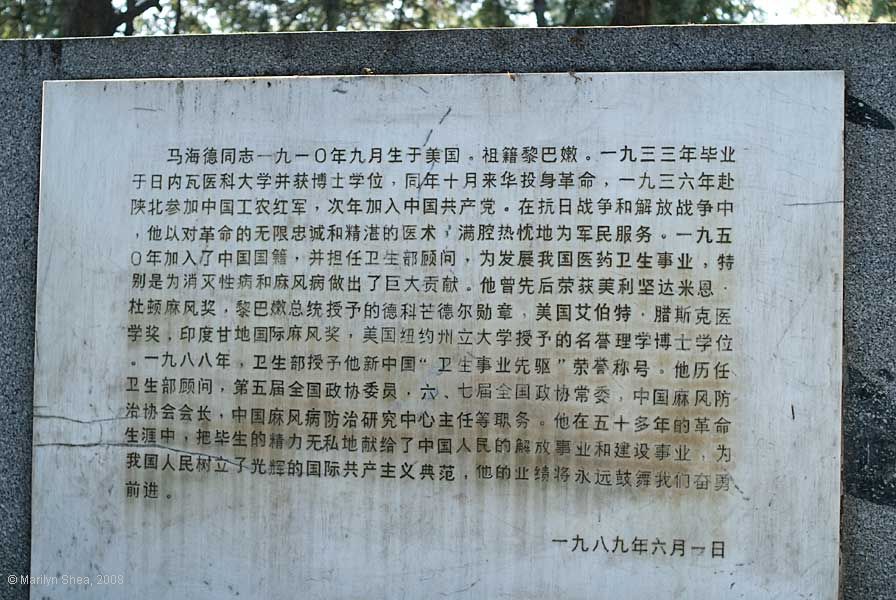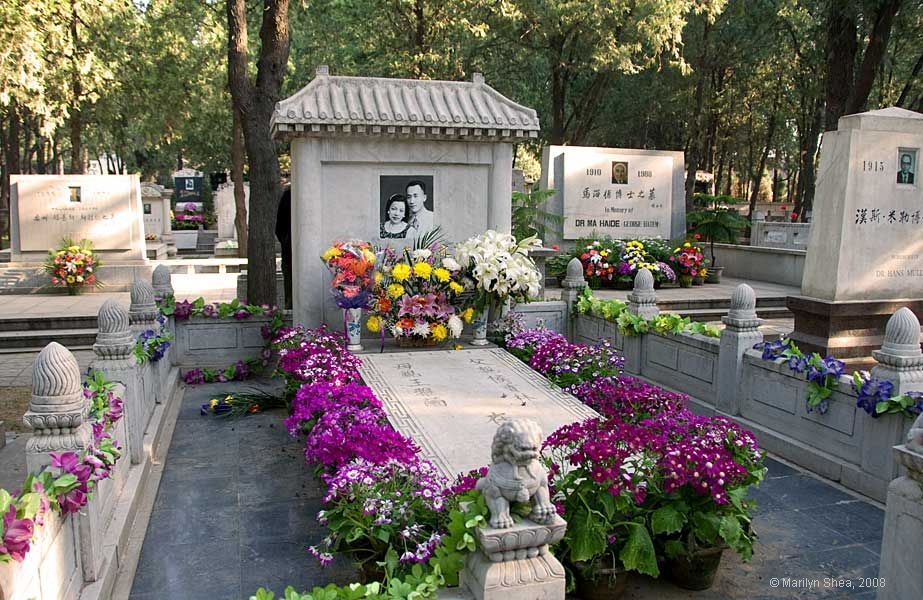Dr. Ma Haide 马海德 (George Hatem)
The reverse side of the tomb of Dr. Ma Haide 马海德 (George Hatem).
George Hatem was born in Buffalo, New York in 1910. His parents had emigrated from Lebanon and were quite poor, working in factory jobs and building a new life. They moved to North Carolina to find better jobs and George went to school there and then on the University of North Carolina. He was an extraordinary student and won a scholarship to attend the American University in Beirut to study medicine. From there he went on to the University of Geneva, one of the premiere research institutions. After graduating, he and Lazar Katz and Robert Levinson decided to go to China to learn more about tropical diseases and treat the needy. He had made several friends from Asian countries in school and was interested in spending some time there and doing what he could to help. They had planned to stay two years and then return to their homes to open practices and begin their careers.
What they found in Shanghai was not what they expected. The health problems weren't due so much to disease as to lack of food and clothing. The children in the factories were being killed by the conditions. It would have been kinder to kill them. Children worked in electroplating factories with no protection. They developed open ulcers on their hands from exposure to mercury and were dead by the age of 14. Children were used to pull silk cocoons out of vats of boiling water with their bare hands. Children were used as oilers - they were small enough to climb inside running machines to oil joints. The often lost arms, legs, fingers, if not their life. Rewi Alley, an Australian, had been appointed Chief Factory Inspector, and although the office was corrupt, Alley was not. In addition to everything else, China was in the midst of a famine that would kill 6 million people. Supplies were scarce. Alley enlisted the young doctors to help him with research and attempts to ameliorate conditions.
Conditions were bad all over China, but they focused their attention on some of the foreign owned companies, feeling that there would be more that they could do there than with local factories and farms. They actually did make some impact, but the war overtook them and the Japanese were moving south and they left Shanghai.
Hatem's plan to return to America was put on hold. In 1937 he changed his name to Ma Haide 马海德 (Mǎ Hǎidé). In addition to Alley, he met other dedicated people who were concerned about the same things he was: Agnes Smedley, Max and Grace Granich, Liu Ting, Hans Shippe, Israel Epstein and most important, Soong Ching-ling (宋庆龄 Song Qingling). Soong Ching-ling was the widow of Sun Yat-sen and one of the daughters of Charlie Soong. She and her sisters had been educated in America and often served as a bridge between foreigners and the Chinese. Her sister, Soong May-ling (宋美龄 Song Meiling) married Chiang Kai-shek. All three sisters worked to bring foreign aid to the people - medical supplies, food aid, and the friendship if those necessary to defeat the Japanese. Song Ching-ling aligned herself with the Communist side of the civil war and Song May-ling and Soong Ai-ling were both married to Nationalists. Over the course of 3 years, from 1933 to 1936 George Hatem became acquainted with the struggle for power in China and finally in 1936, with the help of Soong Ching-ling made it from Nationalist controlled areas in the south to Yan'an and the communist encampment.
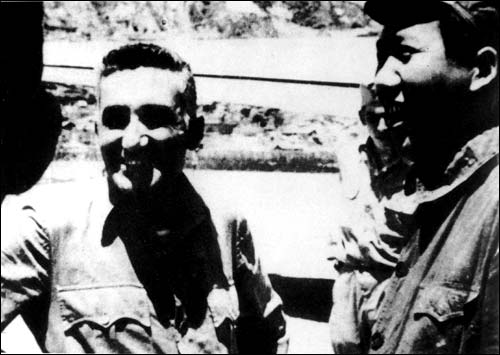 He traveled there with Edgar Snow and Snow's young translator. The permissions and papers for each of them were obtained separately. They joined with a larger group, converging from different places. There was a civil war going on and the Japanese invasion begun in 1931 had pushed the government to the south, while the communist troops were in the northwest mountains. It was both difficult to get permissions to travel and dangerous. He traveled there with Edgar Snow and Snow's young translator. The permissions and papers for each of them were obtained separately. They joined with a larger group, converging from different places. There was a civil war going on and the Japanese invasion begun in 1931 had pushed the government to the south, while the communist troops were in the northwest mountains. It was both difficult to get permissions to travel and dangerous.
When Ma Haide (George Hatem) arrived in Yan'an, he immediately set up to deliver medical care. One of his first patients was Mao Zedong. There had been rumors that Mao was dying and one of the jobs given Ma Haide was to confirm or deny the rumor. Mao was in perfect health and it was felt that the message would be believed if it came from a neutral source, such as a western doctor. It was.
He worked at the Yan'an Hospital, traveled with the 8th Army to Shanxi to set up medical care and then returned to head the Yan'an Hospital. In 1937 he became a member of the Chinese Communist Party. He helped to bring other foreign doctors to Yan'an to help with the work with the aid of people like Agnes Smedley and Soong Ching-ling. He worked with doctors like Norman Bethune (who died while trying to save the life of a soldier near the front lines) and Major Melvin Casberg, who both came to provide medical assistance and organization. In 1942, he transferred to the International Peace Hospital in Yan'an. In 1946 he was part of the Communist Party delegation to the talks held in Beijing with the Nationalists and representatives from the United States. These talks were to organize the disbanding of Japanese governing functions and return the infrastructure to the Chinese.
In 1949, Ma Haide became a Chinese citizen. He was the first foreigner to be granted citizenship. He now knew where his life's work would be. In 1949, Mao sent him to Yunnan in southwest China to set up a public health system for the Miao and other minorities of the region. Mao Zedong was very interested in the minorities at that time, and wished to bring services to this long neglected and forgotten section of China. At that time, the policies were to maintain the language, customs and cultures of the people. Those policies would only change later. There was a lot of work to do. Some of the minorities of the area were in slavery, literally. Most were close to starvation. Ma Haide set up the infrastructure to begin the long road to modernization of healthcare and returned to Beijing.
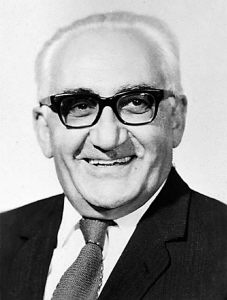 Up to 1950 he had been active in the practice of medicine. After that, he moved into a series of government posts to organize health delivery, spear head research, and modernize the Chinese medical profession. From 1950-53 he was a consultant for the Central People's Government Ministry of Health. Then he worked to help found the Central Institute of Dermatology and Venereal Disease. This focused his attention not only on venereal disease, which had been a specialty since his medical school days, but also on the causes and prevention of leprosy. In 1969, he transferred to Beijing's Fu Wai Hospital to continue the same work and then, in 1977, he moved to the Union Medical College Hospital of Dermatology and was appointed a consultant to the People's Republic of China Ministry of Health. Ma Haide received a number of international awards both for his work in venereal disease, but especially for advances in the treatment of leprosy. Up to 1950 he had been active in the practice of medicine. After that, he moved into a series of government posts to organize health delivery, spear head research, and modernize the Chinese medical profession. From 1950-53 he was a consultant for the Central People's Government Ministry of Health. Then he worked to help found the Central Institute of Dermatology and Venereal Disease. This focused his attention not only on venereal disease, which had been a specialty since his medical school days, but also on the causes and prevention of leprosy. In 1969, he transferred to Beijing's Fu Wai Hospital to continue the same work and then, in 1977, he moved to the Union Medical College Hospital of Dermatology and was appointed a consultant to the People's Republic of China Ministry of Health. Ma Haide received a number of international awards both for his work in venereal disease, but especially for advances in the treatment of leprosy.
He was active in politics to advance the cause of medical research and the expansion of medical care to remote areas. He was a member of the sixth and seventh Standing Committees of the CPPCC National Committee during the 1980s until his death in 1988.
|
